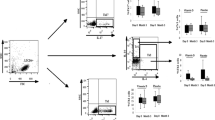Abstract
Fas/FasL-mediated apoptosis results in the destruction of thyrocytes in chronic autoimmune hypothyroidism (CAIH). In this study, we examined the serum levels of soluble Fas (sFas) and soluble sFas ligand (sFasL) in euthyroid patients with chronic autoimmune hypothyroidism, who were taking levothyroxine (euthyroid, LT4-CAIH), to investigate the possible role of thyroid hormone therapy in down-regulation of apoptotic factors. Fifty euthyroid patients with CAIH on levothyroxine (median of duration 36 months, range 6–228 months) were compared with 75 age- and sex-matched healthy individuals. Serum levels of soluble Fas and soluble Fas Ligand, autoantibodies to thyroid peroxide and thyroglobulin were measured using ELISA. Serum levels of sFas were significantly higher in the euthyroid, LT4-CAIH group [median 9.12 ng/ml, interquartile range (7.86–10.72 ng/ml)] than in the controls [6.11 ng/ml (5.60–6.81 ng/ml)] (P < 0.0001). Compared with controls [80.33 pg/ml (68.22–103.70 pg/ml)], the euthyroid, LT4-CAIH group [125.71 pg/ml (106.11–149.48 pg/ml)] had significantly higher levels of sFasL (P < 0.0001). In a chronological study, there was no significant correlation between sFas, sFasL, and the duration of levothyroxine therapy. In conclusion, normalization of serum sFas and sFasL levels cannot be achieved during levothyroxine treatment in patients with CAIH. It appears that levothyroxine therapy has no important effect on down-regulation of apoptotic factors in CAIH. Thus, like thyroid autoantibodies, monitoring of serum levels of sFas/sFasL is not indicated during thyroid hormone therapy.


Similar content being viewed by others
References
S. Nagata, P. Golstein, Science 267, 1449–1456 (1995)
A. Strasser, P.J. Jost, S. Nagata, Immunity 30, 180–192 (2009)
G. Stassi, A. Zeuner, D. Di Liberto et al., Clin. Immunol. 21, 19–23 (2001)
M. Andrikoula, A. Tsatsoulis, Eur. J. Endocrinol. 144, 561–568 (2001)
L.J. Hammond, F.F. Palazzo, M. Shattock et al., Thyroid 11, 919–927 (2001)
L.J. Hammond, M.W. Lowdell, P.G. Cerrano et al., J. Pathol. 182, 138–144 (1997)
J. Cheng, T. Zhou, C. Liu et al., Science 263, 1759–1762 (1994)
T. Suda, H. Hashimoto, M. Tanaka et al., J. Exp. Med. 186, 2045–2050 (1997)
N. Kayagaki, A. Kawasaki, T. Ebata, J. Exp. Med. 182, 1777–1783 (1995)
P. Schneider, N. Holler, J.L. Bodmer et al., J. Exp. Med. 187, 1205–1213 (1998)
S.H. Wang, J.R. Baker, Thyroid 17, 975–979 (2007)
O.A. Sukocheva, D.O. Carpenter, J. Endocrinol. 191, 447–458 (2006)
J.B. Laoag-Fernandez, H. Matsuo, H. Murakoshi et al., J. Clin. Endocrinol. Metab. 89, 4069–4077 (2004)
M. Ghorbel, I. Seugnet, A.M. Ableitner et al., Neurosci Lett. 231, 127–130 (1997)
F. Varga, E. Luegmayr, N. Fratzl-Zelman et al., J. Endocrinol. 160, 57–65 (1999)
M. Hara, S. Suzuki, J. Mori et al., Thyroid 10, 1023–1034 (2000)
N. Saelim, D. Holstein, E.S. Chocron et al., Apoptosis 12, 1781–1794 (2007)
M. Pietrzak, M. Puzianowska-Kuznicka, J. Mol. Endocrinol. 41, 177–186 (2008)
H.Y. Lin, H.Y. Tang, A. Shih et al., Steroids 72, 180–187 (2007)
H.Y. Lin, H.Y. Tang, T. Keating et al., Carcinogen 29, 62–69 (2008)
T.H. Brix, K.O. Kyvik, L. Hegedüs, J. Clin. Endocrinol. Metab. 85, 536–539 (2000)
World Health Organization, United Nations Children’s Fund, International Council for Control of Iodine Deficiency Disorders, Assessment of the Iodine Deficiency Disorders and Monitoring their Elimination. (World Health Organization, Geneva, 2001), WHO document WHO/NHD/01.1
Y. Shimaoka, Y. Hidaka, M. Okumura et al., Thyroid 8, 43–47 (1998)
Y. Hiromatsu, T. Bednarczuk, E. Soyejima et al., Thyroid 9, 341–345 (1999)
C.Y. Wang, W.B. Zhong, T.C. Chang et al., Metabolism 51, 769–773 (2002)
F. Rogowski, A. Parfieńczyk, A. Sopotyk et al., Nucl. Med. Rev. Cent. East Eur. 7, 117–122 (2004)
W. Zhao, B.L. Gao, M. Tian et al., J. Clin. Invest. Med. 32, E158–E165 (2009)
K. Maeda, Y. Ohara, M. Hashimoto, Clin. Ophthalmol. 2, 609–612 (2008)
L. Xerri, E. Devilard, J. Hassoun et al., Mol. Pathol. 50, 87–91 (1997)
S. Fountoulakis, G. Vartholomatos, N. Kolaitis et al., Eur. J. Endocrinol. 158, 853–859 (2008)
J. Myśliwiec, M. Okota, A. Nikołajuk, Adv. Med. Sci. 51, 119–122 (2006)
J. Mysliwiec, M. Oklota, A. Nikolajuk et al., Immunol. Invest. 36, 247–257 (2007)
J. Feldkamp, E. Pascher, M. Schott et al., Clin. Endocrinol. Metab. 86, 4250–4253 (2001)
K. Ohtsuka, M. Hashimoto, Br. J. Ophthalmol. 84, 103–106 (2000)
J. Myśliwiec, A. Kretowski, A. Stepień et al., Pol. Merkur. Lekarski. 17, 368–370 (2004)
M. Andrikoula, N. Kolaitis, G. Vartholomatos et al., Immunol. Invest. 38, 398–407 (2009)
K. Kolomecki, P. Maciaszczyk, H. Stepien et al., Bratisl. Lek. Listy. 106, 297–300 (2005)
B. Rapoport, S.M. McLachlan, J. Clin. Invest. 108, 1253–1259 (2001)
L. Hegedüs, J.M. Hansen, U. Feldt-Rasmussen, Clin. Endocrinol. 35, 235–238 (1991)
Acknowledgments
This study was supported by the grant No 89.1.PGRC of the Persian Gulf Tropical Medicine Research Center, Bushehr University of Medical Sciences, Bushehr, Iran.
Author information
Authors and Affiliations
Corresponding author
Rights and permissions
About this article
Cite this article
Nabipour, I., Kalantarhormozi, M., Assadi, M. et al. Influence of levothyroxine treatment on serum levels of soluble Fas (CD95) and Fas Ligand (CD95L) in chronic autoimmune hypothyroidism. Endocr 38, 406–411 (2010). https://doi.org/10.1007/s12020-010-9401-x
Received:
Accepted:
Published:
Issue Date:
DOI: https://doi.org/10.1007/s12020-010-9401-x




